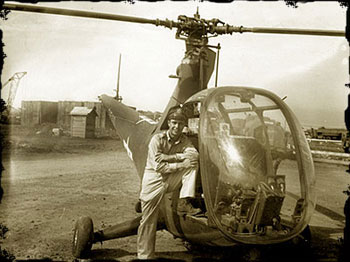
 The Sikorsky designed R-6A
"Hoverfly, two-seat observation helicopter was a refined
version of the R-4, the first Air Force helicopter to serve in a combat zone (May 1944).
First flown in October 1943, the R-6A used the same rotor and transmission system as the
R-4, but had a more powerful engine. The fuselage was completely redesigned to reduce air
resistance and provide improved pilot visibility; therefore, the R-6A bore little
resemblance to its boxy-looking predecessor. Sikorsky built the first six of the
helicopters (one XR-6 and five XR-6As), but
The Sikorsky designed R-6A
"Hoverfly, two-seat observation helicopter was a refined
version of the R-4, the first Air Force helicopter to serve in a combat zone (May 1944).
First flown in October 1943, the R-6A used the same rotor and transmission system as the
R-4, but had a more powerful engine. The fuselage was completely redesigned to reduce air
resistance and provide improved pilot visibility; therefore, the R-6A bore little
resemblance to its boxy-looking predecessor. Sikorsky built the first six of the
helicopters (one XR-6 and five XR-6As), but

[43-45342][43-45343][43-45345][43-45348]
[43-45352][43-45353][43-45355][43-45356]
[43-45370][43-45387][43-45393][43-45398]
[43-45408][43-45409][43-45410][43-45412]
[43-45414]
 |
another 219 R-6As were produced in 1944 and
1945 by Nash-Kelvinator under a Sikorsky License.
Source:
US Air Force
Museum
Although primarily an
observation and liaison helicopter, many R-6As also were equipped with capsules on each
side of the fuselage to carry litters for medical evacuation. If necessary, the R-6A could
be equipped with floats for operation from water.
The Sikorsky (model S-49) R-6 (British name Hoverfly
MK II) was first flown on October 15, 1943. A refinement of the R-4, the R-6 (VS-316B)
featured a larger, improved, streamlined metal fuselage with improved pilot visibility.
This was a joint U.S. Army/U.S. Navy program. It had the same rotor and transmission as
the R-4, but a more powerful 245 hp Franklin O-405-9 engine. It had a crew of two, seated
side-by-side. It was equipped with a high-frequency radio. In the MedEvac role it could be
equipped with two external capsules to carry litters. The R-6A could also be equipped with
pontoons for use over water. The R-6A was the first USAAF helicopter to serve in combat in
May 1944. The initial XR-6 and all five XR-6As were produced by Sikorsky. All R-6As were
produced in 1944 and 1945 by Nash-Kelvinator under license to Sikorsky. The R-6A was used
primarily by the U.S. Navy (as the HOS-1) and the U.S. Coast Guard, as well as the Royal
Navy (as the Hoverfly MK II). Models A thru C were powered by a Pratt & Whitney
R-985-AN-5 450 hp engine. The D model was powered by a Pratt & Whitney R-1340 600 hp
engine.
The specifications are: Main Rotor diameter: 38 Feet |
Overall Length - 33 Feet 8 Inches | Height: 11 Feet 7 Inches | Weight: 2,590
Lbs Max | Armament: 650 Lb. Bombs | Service Ceiling: 13,200 Feet | Engine:
Franklin 0-405-9 | Horsepower: 235 | Maximum Speed: 96 MPH | Crusing Speed:
69 MPH | Range: 305 Miles